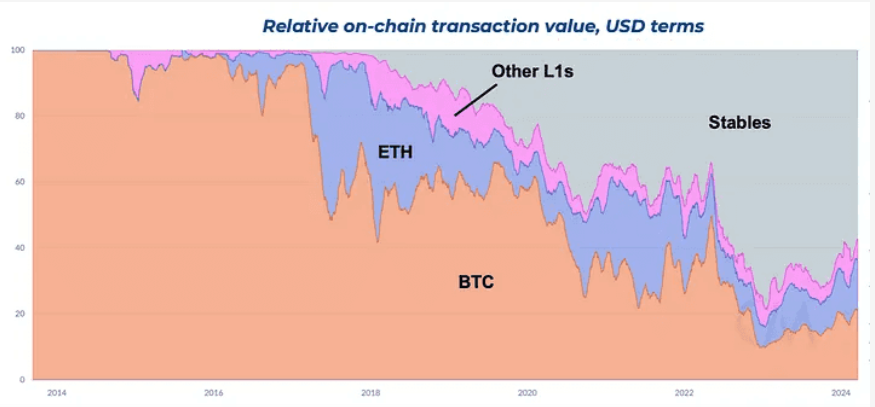Lightning Network is on the right track with stablecoins
Original | Odaily Planet Daily ( @OdailyChina )
Author: Golem ( @web3_golem )

On July 23, Lightning Labs, the main software developer of the Lightning Network, announced the release of an important update of Taproot Assets on the Lightning Network, enabling the Lightning Network to support multi-asset transfers in addition to BTC. Users can now mint Taproot Assets on the mainnet and perform instant, low-cost asset transfers through the Lightning Network.
Lightning Labs believes that this update is of great significance and can help bring the trillion-dollar stablecoin market to Bitcoin, making the US dollar and the world's financial assets Bitcoin-based. So why is Lightning Labs obsessed with developing stablecoins on Bitcoin, and what are its advantages over other asset issuance protocols? These questions will be explored below.
Lightning Network’s obsession with stablecoins
As early as 2022, Lightning Labs launched the Taro protocol, which aims to introduce stablecoins and other assets to Bitcoin and the Lightning Network. In the blog post announcing the protocol, it emphasized the demand for stablecoins for instant settlement in the Lightning Network in countries and regions such as Latin America and West Africa. However, due to a copyright lawsuit in March 2023, the project had to be temporarily suspended.
The launch of Taproot Assets on the mainnet in October 2023 coincided with the blossoming of asset issuance protocols in the Bitcoin ecosystem, so many people thought that Lightning Labs just wanted to join in the fun, but the reality is that Taproot Assets is a continuation of the Taro protocol, and Lightning Labs wanted to issue stablecoins on Bitcoin even earlier than other protocols.
Although the Nostr Assets protocol that introduced Taproot Assets to the Nostr network did create a wave of Taproot Assets wealth effect for a short time, blindly creating new assets was not the original intention of Lightning Labs, and stablecoins are still its key development direction. Ryan Gentry, head of business development at Lightning Labs, wrote at the beginning of the Taproot Assets release blog that "I believe we will see countless global currencies issued as Taproot Assets, and global foreign exchange transactions will be settled instantly through the Lightning Network."
Since then, Lightning Labs has also been advancing the stablecoin experiment. In May 2024, Lightning Labs CEO Elizabeth Stark publicly announced that test transactions had been executed on the Lightning Network using the Taproot Assets protocol, and said that issuing stablecoins on Bitcoin would promote new financial use cases and bring more people into the Internet of Money and Digital Assets.
As of now, Lightning Labs has been quietly developing the technology to support running multiple assets such as stablecoins on Bitcoin and the Lightning Network for two years.
Lightning Network adoption in emerging markets
Since El Salvador announced Bitcoin as legal tender and released several related infrastructures based on Lightning Network payments in mid-2021, the number of Lightning Network nodes and channels has increased rapidly. As of press time, the Lightning Network has a total of 13,474 nodes, nearly 50,000 payment channels, and channel funds of approximately 5,219 Bitcoins (approximately US$347 million).

Number of Lightning Network nodes (left) and channels (right). Data from: bitcoin visuals
It can be seen that the explosive growth of the Lightning Network after 2021 will mainly come from countries and regions with high financial intermediation costs such as El Salvador in Latin America and West Africa. It is more convenient and economical for users to use Bitcoin and the Lightning Network for daily transfer transactions, merchant payments, and cross-border remittances.
Before 2021, cross-border remittances to people living in El Salvador through traditional financial giants such as Western Union required expensive service fees. In 2020 alone, remittance payments accounted for 23% of El Salvador's GDP, or approximately US$5.9 billion. When Bitcoin is used as remittance funds and the Lightning Network is used for cross-border remittances, the service fees are almost zero in comparison.
Lightning Network needs stablecoins
Over the past five years, stablecoins have gradually replaced Bitcoin and accounted for more than 50% of global on-chain transactions. According to K 33 Research, the annual transaction volume of stablecoins in 2023 is $11 trillion , and it is expected to exceed $30 trillion in 2024, more than twice Visa's annual transaction volume.

Source: Castle Island
The global demand for stablecoins is undeniable, and subsequent growth will be mainly driven by emerging markets such as Asia, Africa and Latin America. Tether CEO Paolo Ardoino also said in April this year that in Europe and the United States, which have complete banking systems, no one really needs stablecoins.
In developing countries that lack a sound financial system, people need cheap and stable financial facilities with instant settlement rather than unstable assets. Although the Lightning Network enables users to obtain low-cost and low-latency settlement, as the number and capacity of network channels continue to expand and the requirements of application scenarios continue to increase, the volatility of Bitcoin itself has caused greater transaction friction and has increasingly hindered the development of Bitcoin and the Lightning Network in payment, DeFi and other fields. In this context, the Lightning Network needs to develop stablecoins.
Advantages of Lightning Network in developing stablecoins
The importance of stablecoins to the Bitcoin ecosystem is self-evident. Other Bitcoin ecosystem asset issuance protocols such as BRC 20, Runes, RGB++, etc. are also exploring how to issue stablecoins on the Bitcoin ecosystem and create a DeFi flywheel. However, Taproot Assets with the Lightning Network has their incomparable advantages.
Related functions are complete
In terms of infrastructure, all asset issuers do not need to build their own routing node sub-networks, but can use existing Bitcoin node routing, which allows stablecoins to be quickly applied in established Lightning Network payment channels. In addition, a trustless and custodial on-chain Swap has also been launched. Taproot Assets users and developers can natively exchange assets for Bitcoin or other Taproot Assets through PSBT, which has provided support for subsequent on-chain applications of stablecoins.
Relying on the existing huge user base
Another major advantage of the Lightning Network is that after experiencing rapid growth in the past few years, it has already had a huge base of payment users and partners around the world, especially in emerging markets such as Asia, Africa and Latin America. This makes it easier for stablecoins on the Lightning Network to reach real users and quickly cover application scenarios with the help of partners such as wallets and payment software. The stablecoins issued by other Bitcoin ecosystem asset issuance protocols are equivalent to starting from scratch.
Or get support from stablecoin issuer Tether
Tether is the issuer of USDT, the third largest stablecoin by market value. As early as 2022, it had planned to issue tokens on the Lightning Network in conjunction with Synonym. Tether CEO Paolo Ardoino also supported the development of the Lightning Network on social media, and when Lightning Labs released the Taproot Assets protocol in October 2023, he cited it as "the future." Paolo Ardoino's personal X account profile has the label "bitcoin + P2P", and on July 21, he posted that USDT and the Lightning Network provide payment support for P2P AI agents.

Judging from these clues, perhaps Tether has always had the idea of launching a stablecoin on Bitcoin, and the Lightning Network may be its preferred partner.
Summarize
When the Lightning Network was created, it was to solve the shortcomings of Bitcoin in small payments. After 5 to 6 years of development, the Lightning Network has achieved initial results in Bitcoin small payments. In this process, the vision of the Lightning Network has gradually moved towards "Bitcoinizing the US dollar and world financial assets." When people are encouraged to use Bitcoin in their daily lives, they are also willing to use the Bitcoin network for practices in areas such as DeFi and NFT.
Last October, Lightning Labs supported the minting of Taproot Assets on the Bitcoin mainnet, but did not support transfers on the Lightning Network. More than half a year later, today Lightning Labs supports the transfer of Taproot Assets on the Lightning Network, and is only one step away from bringing stablecoins into the Bitcoin ecosystem.



